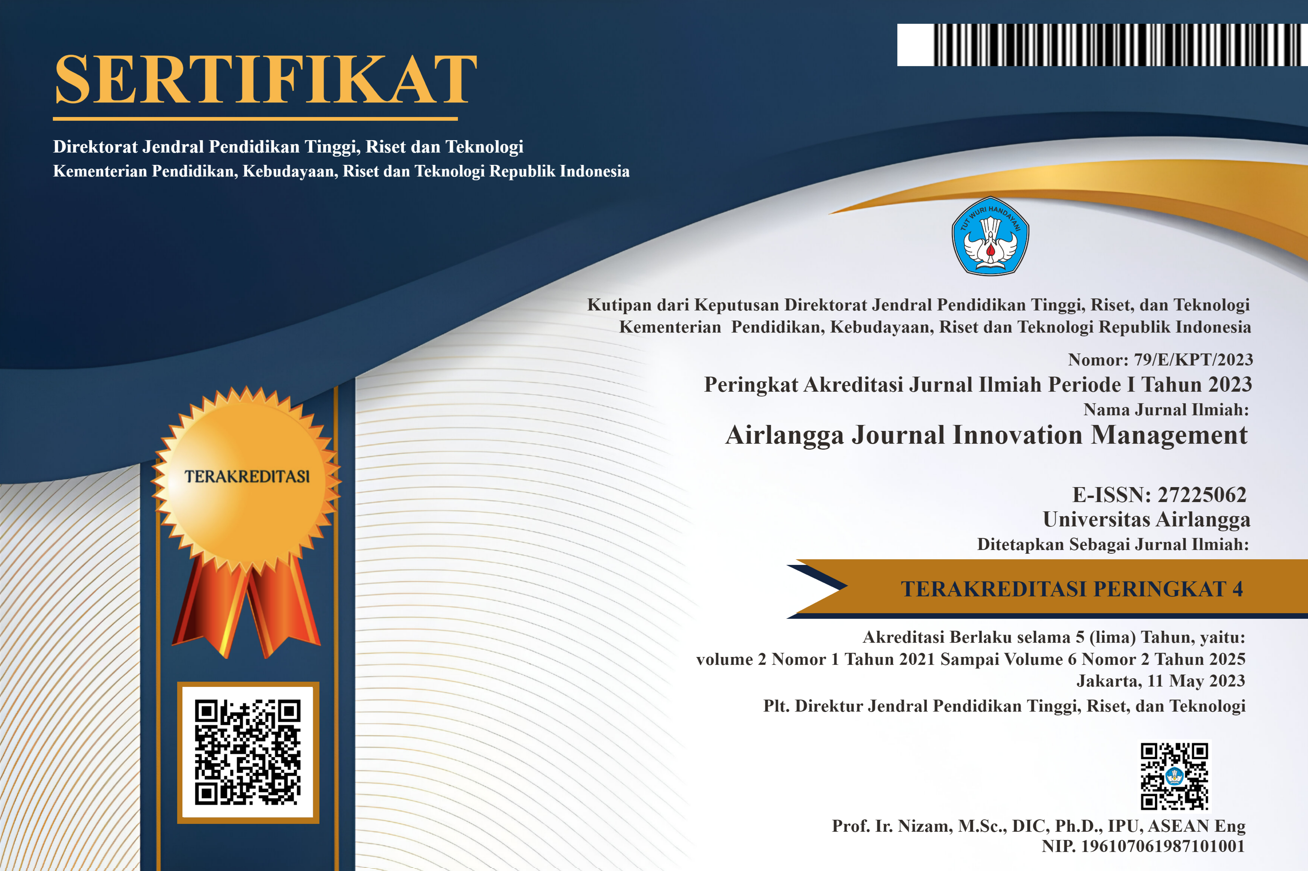The QRIS Effect: What Truly Motivates MSMEs to Go Digital?
QRIS is now usable in several countries through partnerships,enabling Rupiah-based transactions abroad. This study aims to determine the analysis of the effect of QRIS fees, transaction security, service benefits and ease, and use on interest in using QRIS in buying and selling transactions for MSMEs in Indonesia. This study uses primary data obtained from the collection method on a questionnaire with sampling by purposive sampling method. The questionnaire was randomly distributed online to MSMEs in Indonesia. The questionnaire contains items that need to be completed and sent using the google forms platform. As much as 100 data samples tested with data analysis using the Structural Equation Model (SEM) method through the Partial Least Squares (PLS) approach by conducting a convergent validity test, a discriminant validity test, a reliability test, a determination coefficient test (R2), and a path coefficient test. The results showed that QRIS fees, transaction security, service benefits and ease, and use simultaneously had positive and significant effects on interest in using QRIS in buying and selling transactions for MSMEs in Indonesia. Bank Indonesia needs to pay attention to these factors in the broader implementation of QRIS. It needs more promotion to introduce the benefits of QRIS usage for Indonesian MSMEs. This research provides help to policymakers develop QRIS.
Amamilah, S., Mulyadi, D., & Sandi, S. P. H. (2024). Pengaruh Persepsi Kemudahan Penggunaan, Persepsi Efektivitas Dan Persepsi Manfaat Terhadap Minat Penggunaan QRIS Sebagai Alat Transaksi Pembayaran Pada Mahasiswa Universitas Buana Perjuangan Karawang. Journal of Economic, business and Accounting (COSTING), 7(2), 2992–3001. https://doi.org/10.31539/costing.v7i2.7444
Amri, A., Malik, R. F., & Fachrandi, M. K. (2025). Determinants Influencing QRIS Adoption as a Digital Payment Tool in Ciledug, Tangerang City. Airlangga Journal of Innovation Management, 6(1), 154–170. https://doi.org/10.20473/ajim.v6i1.70331
Ardiana, D. P. Y., Welda, Pramawati, I. D. A. A. T., Desmayani, N. M. M. R., & Suandana, N. P. W. (2021). Technology Acceptance Model for evaluating the Use of the Indonesian Standard Quick Response Code (QRIS): a case study of MSMEs in Bali. 2021 6th International Conference on New Media Studies (CONMEDIA), 90–94. https://doi.org/10.1109/CONMEDIA53104.2021.9617186
Arvidsson, N. (2014). Consumer attitudes on mobile payment services – results from a proof of concept test. International Journal of Bank Marketing, 32(2), 150–170. https://doi.org/10.1108/IJBM-05-2013-0048
Aryawati, N. P. A., Mahardika, I. M. N. O., & Wibawa, I. G. J. S. (2022). Persepsi Pengguna QRIS Pada UMKM Di Kota Mataram. Guna Sewaka, 1(2), 35–44. https://doi.org/10.53977/jgs.v1i2.668
Ayodya, W. (2020). UMKM 4.0. Elex Media Komputindo.
Bakhtiar, A., Indra, R., Halim, W., Ferbian, V., & Hidayat, Z. (2023). QRIS as a Drivers of Product Distribution Flows in Indonesia: Factors of Consumer Purchasing Behavior in the Use of Fintech Payments. Journal of Distribution Science, 21(12), 59–69.
Bangsa, J. R., & Khumaeroh, L. L. (2023). The Effect of Perceived Benefits and Ease of Use on the Decision to Use Shopeepay QRIS on Digital Business Students of Ngudi Waluyo University. Manajemen Dan Akuntansi, 3(1), 62–67.
Boston University. (2022). Behavioral Change Models, Diffusion of Innovation Theory. Boston University School of Public Health, 2.
Djoyo, B. W., Nurzaqia, S., Budiarti, S. I., & Agustin, S. (2022). Examining the Determinant Factors of Intention to Use of Quick Response Code Indonesia Standard (QRIS) as a Payment System for MSME Merchants. 2022 International Conference on Information Management and Technology (ICIMTech), 676–681. https://doi.org/10.1109/ICIMTech55957.2022.9915238
Fahrudin, F., & Isnaini, P. L. (2023). Pengaruh Penggunaan Quick Response Code Indonesian Standard (QRIS) Oleh UMKM Terhadap Pendapatan Usaha. Jurnal Manajemen Stratejik Dan Simulasi Bisnis, 4(1), 1–11. https://doi.org/10.25077/mssb.4.1.1-12.2023
Fauziyah, L., & Prajawati, M. I. (2023). Persepsi dan Risiko QRIS sebagai Alat Transaksi Bagi UMKM. Ekonomis: Journal of Economics and Business, 7(2), 1159. https://doi.org/10.33087/ekonomis.v7i2.987
Finaka, A. W. (2023). Ragam Tarif QRIS. Indonesiabaik.Id.
Gotama, B., Ikhsan, R. B., Sriwidadi, T., Prabowo, H., Susilo, A., & Hardiyansyah. (2024). Technology Characteristics and User Perceptions on Behavioral Intention of Quick Response Code Indonesia Standard. 2024 9th International Conference on Business and Industrial Research (ICBIR), 1287–1292. https://doi.org/10.1109/ICBIR61386.2024.10875746
Gunawan, A., Fatikasari, A. F., & Putri, S. A. (2023). The Effect of Using Cashless (QRIS) on Daily Payment Transactions Using the Technology Acceptance Model. Procedia Computer Science, 227, 548–556. https://doi.org/10.1016/j.procs.2023.10.557
Hairani, N., Hanan, F., Omar, M. F., Khalid, K., & Muhamad, M. (2021). Retail Customer Acceptance Toward QR Code Payment System in Malaysia (pp. 505–515). https://doi.org/10.1007/978-3-030-69221-6_38
Hamzah Muchtar, E., Trianto, B., Maulana, I., Alim, M. N., Marasabessy, R. H., Hidayat, W., Junaedi, E., & Masrizal. (2024). Quick response code Indonesia standard (QRIS) E-payment adoption: customers perspective. Cogent Business & Management, 11(1). https://doi.org/10.1080/23311975.2024.2316044
He, Q., Duan, Y., Fu, Z., & Li, D. (2006). An Innovation Adoption Study of Online E-Payment in Chinese Companies. Journal of Electronic Commerce in Organizations, 4(1), 48–69. https://doi.org/10.4018/jeco.2006010104
Jogiyanto, H. (2007). Sistem Informasi Keperilakuan. In Andi Offset.
Jøsang, A. (2007). Trust and reputation systems. Lecture Notes in Computer Science (Including Subseries Lecture Notes in Artificial Intelligence and Lecture Notes in Bioinformatics), 4677 LNCS, 209–245. https://doi.org/10.1007/978-3-540-74810-6_8
Junaedi, Y. B., Nurlia, Alexandriel, J. F., & Anita, T. L. (2024). Sustainable Usage Intention: QRIS (Quick Response Code Indonesian Standard) Payment Acceptance for Small and Medium Enterprises. 2024 9th International Conference on Business and Industrial Research (ICBIR), 0759–0764. https://doi.org/10.1109/ICBIR61386.2024.10875860
Kamal, I., Rizki, R. N., & Aulia, M. R. (2023). The Enthusiasm of Digital Payment Services and Millennial Consumer Behaviour in Indonesia. International Journal of Professional Business Review, 8(2), e0923. https://doi.org/10.26668/businessreview/2023.v8i2.923
Kapoor, K., Dwivedi, Y. K., & Williams, M. D. (2013). IFIP AICT 402 - Role of Innovation Attributes in Explaining the Adoption Intention for the Interbank Mobile Payment Service in an Indian Context.
Kristanty, D. N. (2024). Tren dan Tantangan Keamanan Bertransaksi dengan Qris dalam Era Transformasi Sistem Pembayaran Digital. 5(10), 3923–3933.
Kurnia Rahman, A. F. S., & Supriyanto, S. (2022). Analisis Faktor Yang Mempengaruhi Minat Penggunaan Qris Sebagai Metode Pembayaran Pada Masa Pandemi. Indonesian Scientific Journal of Islamic Finance, 1(1), 1–21.
Kusuma, L., Deniswara, K., & Gui, A. (2023). Customer Experience Perspective on Quick Response Code Indonesia Standard Payment Method. 2023 International Conference on Information Management and Technology (ICIMTech), 633–638. https://doi.org/10.1109/ICIMTech59029.2023.10277927
Kuswoyo, D. A., Stephen, Gunawan, I. P., & Cassandra, C. (2024). The Influence of QRIS Payment Method Usage and Effectiveness Level on Small and Medium Enterprise (SME). 2024 International Conference on Electrical Engineering and Computer Science (ICECOS), 228–233. https://doi.org/10.1109/ICECOS63900.2024.10791218
Lestari, M. I. (2023a). Kesediaan Micro Merchants Membayar Biaya Merchant Discount Rate dan Biaya Settlement QRIS. InFestasi, 19(1), 39–50. https://doi.org/10.21107/infestasi.v19i1.19695
Lestari, M. I. (2023b). Kesediaan Micro Merchants Membayar Biaya Merchant Discount Rate dan Biaya Settlement QRIS. InFestasi, 19(1), 39–50. https://doi.org/10.21107/infestasi.v19i1.19695
Michael, G., Widjaya, W., & Gui, A. (2024). Analysis of Factors Affecting Behavioral Intention to Use QRIS. 2024 Second International Conference on Emerging Trends in Information Technology and Engineering (ICETITE), 1–6. https://doi.org/10.1109/ic-ETITE58242.2024.10493415
Musadad Rusydi, A., Handayani, D., & Tanjung, M. (2024). Continuance Usage of QR Mobile Payment: System Quality Analysis. 2024 International Conference on ICT for Smart Society (ICISS), 1–8. https://doi.org/10.1109/ICISS62896.2024.10751159
Musyaffi, A. M., Johari, R. J., Rosnidah, I., Sari, D. A. P., Amal, M. I., Tasyrifania, I., Ayu Pertiwia, S., & Sutanti, F. D. (2021). Digital Payment During Pandemic: An Extension of The Unified Model of QR Code. Academic Journal of Interdisciplinary Studies, 10(6), 213. https://doi.org/10.36941/ajis-2021-0166
Noviatun, I., & Riptiono, S. (2021). Menguji Intention to Use E-Wallet OVO Menggunakan Modifikasi Technology Acceptance Model (TAM) di Kebumen. Jurnal Ilmiah Mahasiswa Manajemen, Bisnis Dan Akuntansi (JIMMBA), 3(1), 193–201. https://doi.org/10.32639/jimmba.v3i1.777
OCBC. (2025, December 12). Cara Menggunakan QRIS di Luar Negeri dan Daftar Negaranya! OCBC.
Odeta, F., Augusto, P. D., Lie, K. G., Gui, A., Shaharudin, M. S., & Ganesan, Y. (2023). Analysis of Factors that Affect Users of Quick Response Indonesia Standard. 2023 International Conference of Computer Science and Information Technology (ICOSNIKOM), 1–6. https://doi.org/10.1109/ICoSNIKOM60230.2023.10364457
Palupi, A. A., Hartati, T., & Sofa, N. (2022). Pengaruh Literasi Keuangan Dan Kemudahan Penggunaan Sistem Qris Terhadap Keputusan Bertransaksi Menggunakan Qris Pada UMKM. Seminar Nasional Riset Terapan, Vol 10,1, 1–9.
Patil, N., & Kondabala, R. (2022). Two-Layer Secure Mechanism for Electronic Transactions. 2022 International Conference on Recent Trends in Microelectronics, Automation, Computing and Communications Systems (ICMACC), 174–181. https://doi.org/10.1109/ICMACC54824.2022.10093478
Pratama, R., Hadady, H., & Bailusy, M. N. (2022). Determinants of Use of the Indonesian Standard Quick Response Code (QRIS) on MSMEs in Ternate City. International Research and Critics Institute Journal, 5(2), 10384–10392.
Rafiani, K. M., Yunanda, R. A., & Rusmanto, T. (2024). DETERMINANTS OF QRIS USAGE AS A DIGITAL PAYMENT TOOL FOR MSMES. Journal of Theoretical and Applied Information Technology, 102(3), 1158–1171.
Rahmadi, A. N., Hermawan, A., & Putra, Y. P. (2024). CONVENIENCE PERCEPTION AND SECURITY ON INTEREST OF MSMEs IN USING QRIS. DIVERSITY Logic Journal Multidisciplinary, 2(2), 48–55. https://doi.org/10.61543/div.v2i2.81
Rogers, E. M. . (1995). Diffusion of innovations. Free Press.
Saputri, O. B. (2020). Consumer Preferences in Using the Quick Response Code Indonesia Standard (QRIS) as a Digital Payment Tool’. Journals of Economics and Business Mulawarman, 17(2), 237–247.
Shofihawa. (2025, April 23). QRIS Strengthens Indonesia’s Digital Sovereignty Without Hindering Global Trade. Universitas Gadjah Mada Faculty of Economics and Business.
Silaen, M. F., Manurung, S., & Nainggolan, C. D. (2021). Effect Analysis Of Benefit Perception, Ease Perception, Security And Risk Perception Of Merchant Interest In Using Quick Response Indonesia Standard (Qris). International Journal of Science, Technology & Management, 2(5), 1574–1581. https://doi.org/10.46729/ijstm.v2i5.313
Sriekaningsih, Dr. A. (2020). QRIS dan Era Baru Transaksi Pembayaran 4.0. Penerbit Andi.
Sudiatmika, I. A. O. M. dan N. B. P. (2022). Faktor-Faktor Mempengaruhi Niat Pelaku UMKM Kota Denpasar Menggunakan QRIS. Jmm Unram, 11(3), 239–254.
Syafaastuti, S., Delfina, Y., & Syahchari, D. H. (2024). The Use of the Technology Acceptance Model (TAM) to Analyze the Effects of Social Influence on the Interest in Implementing Cashless Payment (QRIS). 2024 7th International Conference of Computer and Informatics Engineering (IC2IE), 1–6. https://doi.org/10.1109/IC2IE63342.2024.10748219
Syanova, R., & Fajar, A. N. (2024). Analysis of Factors That Influence Use Behaviour of Using Qris Payments for Umkm in Bekasi. Journal of Logistics, Informatics and Service Science. https://doi.org/10.33168/JLISS.2024.0717
The Econopest. (2024, October 18). Cara Menggunakan QRIS Livin Bank Mandiri di Malaysia, Thailand, dan Singapura.
Tian, Y., Chan, T. J., Liew, T. W., Chen, M. H., & Liu, H. N. (2024). Does personal innovativeness and personal anxiety matter? The predictors of continuance use intention of an e-wallet system. Kybernetes. https://doi.org/10.1108/K-10-2023-2213
Tiovilda, N. C., & Melissa, E. (2025). Investigating the Technology Acceptance of QRIS Payment Among Indonesian Generation X. 2025 19th International Conference on Ubiquitous Information Management and Communication (IMCOM), 1–7. https://doi.org/10.1109/IMCOM64595.2025.10857494
Usman, O., Alianti, M., & Fadillah, F. N. (2024). Factors affecting the intention to use QRIS on MSME customers. International Journal of Applied Economics, Finance and Accounting, 18(1), 77–87. https://doi.org/10.33094/ijaefa.v18i1.1323
Usmiati, Huda, N., & Claudia, M. (2024). Qris, blockchain, ai, and iot: enhancing e-commerce transaction security. 1013–1023.
Vincent, O. R., Okediran, T. M., Abayomi-Alli, A. A., & Adeniran, O. J. (2020). An Identity-Based Elliptic Curve Cryptography for Mobile Payment Security. SN Computer Science, 1(2), 112. https://doi.org/10.1007/s42979-020-00122-1
Wahyu Agung Prasetyo, Y., Rahim, R., Manuhutu, M. A., & Sujito, S. (2023). QRIS and GOST: A Symbiotic Approach for Secure QR Code Transactions. SSRG International Journal of Electronics and Communication Engineering, 10(5), 138–147. https://doi.org/10.14445/23488549/IJECE-V10I5P113
Wardhani, R. A., Arkeman, Y., & Ermawati, W. J. (2023). The Impact of Quick Response Adoption of Payment Code on MSMEs’ Financial Performance in Indonesia. International Journal of Social Service and Research, 3(3), 869–878. https://doi.org/10.46799/ijssr.v3i3.294
Waspada, I. (2012). Percepatan Adopsi Sistem Transaksi Teknologi Informasi Untuk Meningkatkan Aksesibilitas Layanan Jasa Perbankan. Jurnal Keuangan Dan Perbankan, 16(1), 122–131.
Wijaya, H. A., Nugroho, R. A., & Nur Hanifah, R. (2024). MSME Perspective on Sustaining QRIS Adoption Towards Smart Economy. 2024 International Conference on ICT for Smart Society (ICISS), 1–10. https://doi.org/10.1109/ICISS62896.2024.10751399
Wiryawan, D., Luhukay, D., Suhartono, J., Pitchay, A. A., Ganesan, Y., & Gui, A. (2023). Analysis of Factors Influencing the Use of QRIS on Museum Visitors with the Extended TAM Model. 2023 11th International Conference on Cyber and IT Service Management (CITSM), 1–6. https://doi.org/10.1109/CITSM60085.2023.10455325
Copyright (c) 2025 Airlangga Journal of Innovation Management

This work is licensed under a Creative Commons Attribution-NonCommercial-ShareAlike 4.0 International License.
- The journal allows authors to hold copyright without restrictions and retain publication rights without restrictions. The author retains the copyright and grants the first publication rights to the journal, with his work simultaneously licensed under the Creative Commons Attribution-NonCommercial-ShareAlike 4.0 International License (CC BY-NC-SA). This license allows others to share the work with acknowledgment of authorship and initial publication in this journal, provided that the work is not used for commercial purposes and that any derivative works must use the same license.
- Authors may enter into additional contractual agreements for non-exclusive distribution of the journal publication version (e.g., uploading it to an institutional repository or publishing it in book form), while still including acknowledgment of the initial publication in this journal.
- Authors are allowed and encouraged to upload their work online (e.g., in an institutional repository or personal website) before and during the submission process. This can support productive scientific exchanges as well as increase citations to published works.

AJIM by UNAIR is licensed under a Creative Commons Attribution-NonCommercial-ShareAlike 4.0 International License.





















